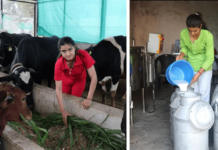The USDA released December and 2020 annual “mailbox” milk price summaries, providing yet another illustration of how the COVID-19 pandemic disrupted milk marketing last year. When compared to the USDA’s all-milk prices, the price differences also reflect challenges to dairy risk management.
First, a disclaimer of sorts. Comparing the all-milk price and mailbox price isn’t exactly apples to apples.
The all-milk price is the gross milk price farmers receive and includes quality, quantity and other premiums. Prices are reported monthly by the USDA National Ag Statistics Service (NASS). The all-milk price is the average price all grades and qualities of milk before deductions (hauling subsidies are excluded). Prices received represent sales from producers to first buyers. All-milk prices are also used to calculate the monthly Dairy Margin Coverage (DMC) margin to determine any indemnity payments.
The mailbox price is defined as the net price received by producers for milk, including all payments received for milk sold, and deducting costs associated with marketing the milk. Data included in all payments for milk sold are: over-order premiums; quality, component, breed and volume premiums; payouts from state-run over-order pricing pools; payments from super pool organizations or marketing agencies in common; payouts from programs offering seasonal production bonuses; and monthly distributions of cooperative earnings. Annual distributions of cooperative profits/earnings or equity repayments are not included.
Included in mail price costs associated with marketing milk are: hauling charges; cooperative dues, assessments, equity deductions/capital retains and reblends; the Federal Milk Marketing Order (FMMO) deduction for marketing services; and federally mandated assessments such as the dairy checkoff and budget sequestration deductions. In 2020, negative producer price differentials (PPDs) played a prominent role on the deduction side. Other deductions, such as loan, insurance or feed mill assignments are not included. For all markets, the mailbox price is reported at the handlers’ average butterfat test (i.e., no adjustment to 3.5%).
And the average all-milk and mailbox prices do not necessarily reflect the same geographic areas. While NASS reports monthly average all-milk prices for the 24 major dairy states, the mailbox prices are reported by the USDA’s Agricultural Marketing Service (AMS) and covers selected FMMO marketing areas. The all FMMO mailbox price is the weighted average of prices for all FMMO reporting areas for which prices are reported for at least 75% of the milk marketed under FMMOs.
For example, while NASS reports an all-milk price for Georgia, the mailbox price lumps Georgia with other Southeast states: Alabama, Arkansas, Louisiana and Mississippi. Similarly, Kansas is part of the Corn Belt states, Oregon and Washington and combined in the Northwest states, Vermont is among six New England states and Virginia is clustered with Kentucky, North Carolina, South Carolina and Tennessee among Appalachian states.
In Table 1, Progressive Dairy attempts to align the state-level NASS all-milk prices and the AMS FMMO marketing area mailbox prices as closely as possible.



































